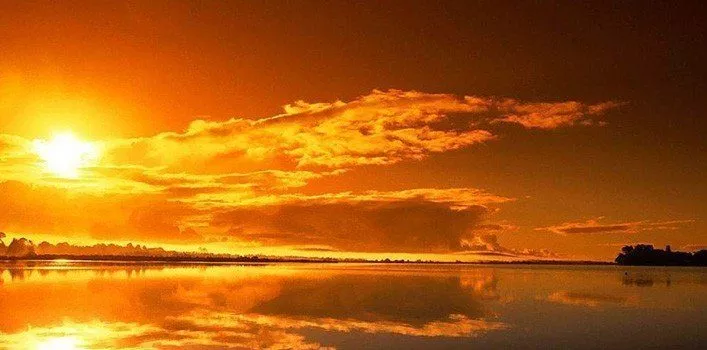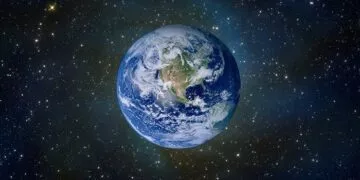The Sun sits at the center of our Solar System, and at the center of our lives.
It marks the passage of time for us, gives us light to grow food and its rays nourish the all the life on our planet – allowing us to thrive.
It also creates some of the most beautiful visual effects in the sky.
When you think of all the Sun does for us you can understand why some cultures worshiped it as a God.
And when you read these awesome facts about the Sun you, too, will be in awe of our star like those ancient races.
The Sun weighs an incredible 1,989,100,000,000,000,000,000 billion kilograms. That’s roughly the weight of 330,060 Earths!
If the Sun was hollow, then it could be filled up with approximately 960,000 spherical Earths. However, if the Earths were squashed inside the hollow Sun with no space wasted then about 1,300,000 would fit inside.
The Sun’s surface area is 11,990 times greater than the surface area of the Earth.
Our Sun is just one of approximately 100 billion stars in the Milky Way galaxy!
Many believe that there are nine planets orbiting around the Sun in our Solar System – these being Mercury, Venus, Earth, Mars, Jupiter, Saturn, Uranus and Neptune. However, there are technically only eight as Pluto is classified as a Dwarf Planet.
There are also four other Dwarf Planets kept in orbit by our Sun’s massive gravitational pull. These are Ceres, Haumer, Makemake and Eris.
The Sun is the impeccably perfect size, shape, brightness, age, temperature and distance for life to exist on Earth. If it were any different in these categories – ever so slightly – life as we know it wouldn’t exist.
The Sun started out its life-cycle like all other stars do, as a gas cloud called a Nebula. Initially the gas and dust which created our Sun would have been in the form of a dense cloud that would have been approximately -226 degrees Celsius. Parts of this cloud would have started to collapse under their own gravity to form flecks called Proto-Stars.
As the Proto-Stars collapse, gravitational energy is converted into heat and this causes the Proto-Star to glow red. It continues to condense until nuclear reactions within its core halt the gravitational collapse. This means the Proto-Star has become a Star and is in its Main Sequence.
At 4.6 billion years old, our Sun is in its Main Sequence stage and considered a middle-aged star. This means it is halfway through its life and it is currently known as a Yellow Dwarf.
When all of the Hydrogen in the Sun has burned up, it will continue to burn all the Helium within it for about 130 million years. During this time it will expand to the point that it will swallow Mercury, Venus and the Earth. By this point our Sun will have become a Red Giant.
After the Sun has transitioned through the red giant phase, its outer layers will be ejected as the core continues to shrink. This process is known as a planetary nebula and is defined as a shell of hot gas that is expelled from a star going through its late stages of evolution.
As this happens the Sun’s core will retain its gigantic mass, but will contain the approximate volume of our planet. When this happens it will be known as a White Dwarf, which will be surrounded by the planetary nebula.
The Sun’s gigantic mass is accountable for 99.86% of the mass in our Solar System.
The composition of the Sun is roughly 75% Hydrogen and 25% Helium. Various metals make up less than 0.1% of the Sun’s mass.
The Sun is surrounded by a plasma aura called a ‘corona’ – that’s Latin for ‘crown’. The Sun’s corona reaches millions of kilometers out into space and it is seen most easily during a total solar eclipse.
However, there is a specialist type of telescope called a ‘coronagraph’, with which you can view things very close to Sun like its corona, other planets and sun-grazing comets. It works by using a disk to block out the Sun’s bright surface.
With a mean distance of 150 million kilometers from the Sun to the Earth, it takes light roughly eight minutes and 20 seconds to travel to the Earth.
Although it only takes the Sun’s rays less than 10 minutes to travel to the Earth, it will have already taken millions of years for them to travel from the Sun’s core to its surface.
Although the mean distance between the Sun and the Earth is 150 million kilometers, the distance itself actually fluctuates yearly. This is because the Earth moves around the Sun on an elliptical orbit, meaning that the distance between the two varies from 147 to 152 million kilometers. The distance between the Sun and the Earth is known as an Astronomical Unit (AU).

If you were to take a journey to the Sun in a normal airliner flying at its regular speed (about 644km/h), it would take you 20 years to get there without stopping!
There is only a 10 kilometer difference in the Sun’s polar diameter when compared with its equatorial diameter. This means it is almost a perfect sphere.
Unlike the Earth, which makes a rotation once every 24 hours, the Sun rotates on its axis once every 25 days. Well, once every 25 days at its equator, and once every 36 days at its poles. This is because the Sun’s rotation rate decreases with increasing latitude, when combined with the tilt of the Sun’s axis, it means that the rotation of the poles happens at a slower speed than the rotation of the equator. Think of if you put a pencil through an apple at an angle so it protruded out of the top and bottom of the apple. Now if you turned the apple, the middle of the apple would make a full rotation quicker than the pieces of pencil sticking out at an angle.
The Sun is 24,000 – 26,000 light years away from the galactic center, and it takes the Sun 225 – 250 million years to complete an orbit of the Milky Way’s center.
While completing this orbit the Sun travels at 136.7 miles per second.
Energy within the Sun’s core is generated through nuclear fusion, as Hydrogen converts to Helium. The energy output of the Sun is roughly 386 billion Megawatts.
Due to the fact that Helium is lighter than Hydrogen, every time Hydrogen nuclei fuse together to create Helium nuclei within the Sun’s core, it loses a small amount of its mass.
During the nuclear fusion process that takes place within the Sun, the core can reach staggering temperatures of 150 million degrees Celsius.
The surface of the Sun is approximately 5,500 degrees Celsius, although this seems chilly in comparison to the core’s temperature.
As the Sun creates energy within its core, the heat from this causes expansion. If not for its enormous gravitational force, the Sun would explode like a giant bomb.
The Sun has an incredibly powerful magnetic field, and due to this it has many magnetic storms. During these magnetic storms solar flares occur, and we can see them when looking at photos of the Sun, where they show as (comparably) dark spots on its surface. These are called Sunspots, and in Sunspots the magnetic lines in the storms are twisted and they spin, similar to a tornado on Earth.
The number of Sunspots appearing on the Sun varies significantly, with a peak number of Sunspots being visible about every 11 years. This means that the Sun has a cycle of behavior which repeats itself every 11 years.
The Sun sometimes generates something called solar winds, which are streams of charged particles like protons and electrons that travel through the Solar System at roughly 450 kilometers per second.
These solar winds are created when when the particle stream builds up enough kinetic energy to escape the Sun’s intense center of gravity and the Sun’s corona.
Solar winds can be responsible for several different inconveniences experienced by mankind such as radio interference, as well as the way they often alter the trajectory of spacecraft.
Solar winds also create some of space’s more beautiful phenomenons such as the dazzling tails of comets and the Aurora Borealis, or The Northern Lights.
Planets like the Earth that have strong magnetic fields tend to deflect most of the charged particles that make up solar winds as they approach the planet.
Over mankind’s history the Sun has played a huge influence in many ancient religions. Often viewed as the giver of life, many early cultures saw the Sun as a deity. The Egyptians had a Sun God named Ra, and the Aztecs also had a Sun God called Tonatiuh.
Many centuries ago astrologers believed that the Earth was the center of the our Universe, with the Sun as a planet orbiting it. They thought that the Moon was the closest planet, then either Mercury, Venus or the Sun as the next-closest planet, with Jupiter and Saturn orbiting the Earth the furthest away.
If the Sun’s bright surface was removed, we would only see darkness. Although the Sun’s outer surface glows bright enough to burn your retinas, the Sun’s core is pitch black.

















